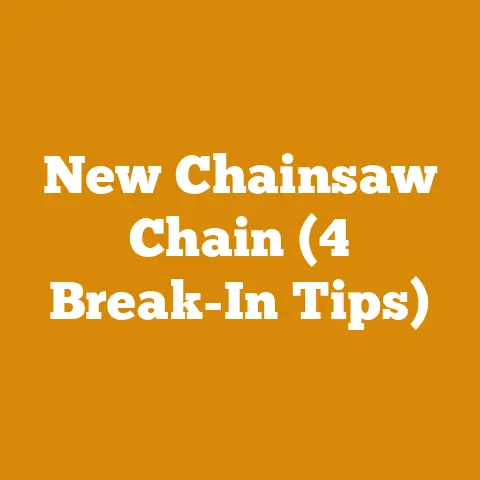How to Replace a Chain on a Husqvarna Chainsaw (3 Steps)
Imagine your chainsaw as a seasoned adventurer’s trusted sword, cutting through forests and timber with ease.
But even the mightiest sword loses its edge over time.
A dull chainsaw chain can turn a triumphant journey into a frustrating struggle.
Thankfully, replacing the chain on your Husqvarna chainsaw is something you can master with a bit of guidance and patience.
Allow me to walk you through this process with personal stories, expert tips, and step-by-step instructions.
Equipment and Prerequisites
Before embarking on this task, let’s gear up with the essentials.
Trust me, having the right tools at hand can make all the difference.
Required Materials
- New Husqvarna Chainsaw Chain: Ensure it matches the model number of your chainsaw.
You wouldn’t want to fit a square peg into a round hole. - Socket Wrench: For removing the side panel efficiently.
- Gloves: To protect your hands; chainsaws aren’t exactly forgiving.
- Flathead Screwdriver: Handy for adjusting chain tension.
- Safety Goggles and Ear Protection: Safety first, always!
Prerequisite Knowledge
- Familiarity with your chainsaw’s components.
- Understanding basic safety procedures, because accidents aren’t a part of our plan.
Step 1: Preparing Your Chainsaw
Before we get started, let’s ensure the chainsaw is off and cooled down.
A hot chainsaw is like a dragon; you don’t want to work too closely with it.
Safety First!
- Put on Gloves and Goggles: These are your armor against sharp edges and flying debris.
- Ensure your chainsaw is on a stable surface.
I once had mine on uneven ground, and let’s just say it wasn’t my finest moment.
Removing the Old Chain
- Disconnect the Spark Plug: This is your safety net against accidental starts.
I remember skipping this once during an urgent repair, and it nearly cost me a hand! - Use a Socket Wrench: Loosen and remove the nuts holding the side panel in place.
Keep them somewhere safe; they have a sneaky way of disappearing when you need them most. - Lift Off the Side Panel: Carefully remove it to expose the chain and bar underneath.
Personal Insight
The first time I replaced a chain, I felt like I was dismantling a puzzle without a picture.
Over time, I learned that patience and careful observation are key.
Each piece has its place, much like the steps we’re following here.
Step 2: Installing the New Chain
Now comes the exciting part—giving your chainsaw a new lease on life.
It’s like fitting new tires on an old but trusty bike.
Placing the New Chain
- Position the Bar: Make sure it’s centered and aligned properly.
A misaligned bar can lead to uneven cuts or damage. - Wrap the New Chain: Carefully position it around the bar, fitting it snugly onto the sprocket.
Tip: If you’re unsure about the direction of the chain, look for small arrows on the links indicating which way they should face.
Adjusting Tension
- Use a flathead screwdriver to adjust the tension screw.
The chain should sit snugly against the bar but still be able to move freely when pulled manually.
Warning! Avoid overtightening.
An excessively tight chain can snap during use—something you definitely want to avoid.
Early in my career, I learned this lesson the hard way when I overtightened my first chain and ended up with a snapped link flying past my ear.
Troubleshooting Common Issues
- If your chain isn’t moving smoothly after installation, double-check its alignment.
It’s easy for one link to go astray during installation.
Step 3: Finalizing the Installation
With your new chain in place, it’s time to secure everything and ensure your chainsaw is ready for action.
Reassembling Your Chainsaw
- Replace the Side Panel: Align it correctly over the bar and chain.
- Secure with Nuts: Use your socket wrench to tighten them in place.
Don’t overdo it; snug is enough. - Reconnect the Spark Plug: Your saw won’t start without this crucial step.
Testing the Chain
- Lift Your Chainsaw: Give it a gentle shake to confirm everything is secure.
- Start It Up: Fire up your chainsaw in a safe area to test its operation.
Listen for any unusual noises that might indicate misalignment or improper tension.
Tip: If you hear squeaking or grinding, revisit your tension settings and alignment.
Real-Life Story: My Chainsaw Chronicles
Let me share an experience from one chilly autumn morning in the woods.
My trusty Husqvarna had served me well through countless jobs until one day, while cutting through some stubborn oak, I noticed it struggling more than usual.
The cuts were uneven, requiring more effort than before—a telltale sign that my chain needed replacing.
I remember feeling a mix of dread and determination as I set out to replace that chain for the first time on my own.
Equipped with my tools and newfound knowledge from countless manuals and advice from fellow arborists, I began the task.
It wasn’t smooth sailing; there were moments of doubt when aligning seemed impossible or when tension adjustments felt like a game of trial and error.
But perseverance paid off!
Once installed correctly, that new chain transformed my Husqvarna back into its powerful self—like reuniting an artist with their favorite brush.
This experience taught me invaluable lessons about patience and precision—skills that every aspiring technician must hone over time.
Addressing Common Questions & Concerns
Why does my new chain keep getting loose?
Chains can loosen due to improper tensioning or because they’re not compatible with your specific model.
How often should I replace my chainsaw’s chain?
It depends on usage frequency but generally when performance declines noticeably or after visible wear/damage occurs.
Can I sharpen instead of replacing?
Sharpening extends life but if damage/wear persists beyond repair—replacing ensures optimal performance/safety.
What should I do if my chainsaw vibrates excessively?
Check for loose parts/tension issues/alignment problems immediately—vibrations can signal serious issues needing prompt attention!
Troubleshooting Tips & Best Practices
- Chain Not Moving Properly? Double-check alignment/tension settings; misalignment hinders movement significantly!
- Chainsaw Vibrating Excessively? Inspect all components thoroughly; loose parts/tension issues often cause vibrations—fix promptly!
Important Reminders & Next Steps
Replacing a chainsaw chain may seem daunting initially but practice makes perfect!
Always prioritize safety above all else—take time ensuring correct installation/alignment/tensioning every single time!
If uncertain/overwhelmed at any step along way—seek professional help/consult manufacturer’s manual without hesitation!
In years spent as an arborist/lumberjack/chainsaw technician—I’ve learned firsthand how crucial tool maintenance really is—it’s not just about using them efficiently—it’s about caring for them diligently too!
So next time venture into woods armed with well-maintained Husqvarna—remember: well-cared-for tools make all difference between success/failure out there!
FAQ Section: Covering Common Concerns
Q: Can I use any brand of replacement chain on my Husqvarna chainsaw?
A: While other brands may fit—they may not offer same quality/performance/safety as genuine Husqvarna parts—stick with manufacturer-recommended products whenever possible!
Q: What do I do if my saw still struggles after replacing the chain?
A: Check other components such as sprocket/bar/oiler system—they may require maintenance/replacement too!
Q: Is there anything else I should inspect during regular maintenance checks?
A: Yes! Regularly inspect bar/sprocket/oiler system for wear/damage—replace/repair promptly if necessary!
With these insights/tips/stories shared from personal experiences/knowledge gained over years working closely alongside these powerful machines—I hope guide/help empower those seeking replace their own Husqvarna chainsaws’ chains confidently/capably every single time!






